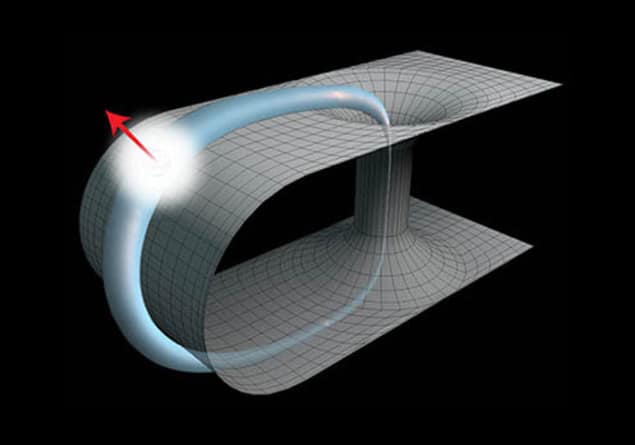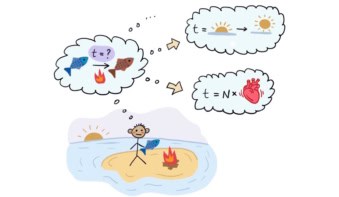
Physicists in Australia claim to have simulated time travel using fairly standard optical equipment on a lab bench. They say they have prepared photons that behave as if they are travelling along short cuts in space–time known as “closed time-like curves”, and add that their work might help in the long-sought-after unification of quantum mechanics and gravity. Others, however, argue that the research does little or nothing to establish whether time travel is possible in nature.
Although everyday experience suggests the impossibility of travelling backwards or forwards in time, Einstein’s general theory of relativity does not rule it out. The theory allows for loops in space–time called closed time-like curves that could be created by very powerful sources of gravity such as black holes. These structures would bring an object back to a place and a time that it had already passed through, typically via a short cut between the two separated regions of space–time known as a wormhole.
Grandfather clause
In classical physics the existence of closed time-like curves would lead to a number of paradoxes. One of the best known of these is the grandfather paradox, in which someone who has travelled backwards in time kills their grandfather while he is still young, thereby preventing their own birth. In quantum mechanics, however, such paradoxes can be avoided.
The quantum-mechanical equivalent of the grandfather paradox involves a subatomic particle that has two states – one and zero – corresponding to “alive” and “dead”. The paradox emerges if the particle started out in state one, travelled backwards in time, met a younger version of itself and then flipped the value of its earlier self to zero.
But in 1991 David Deutsch of Oxford University showed that the probabilistic nature of quantum mechanics comes to the rescue. Deutsch found that there would always be a state that a quantum particle could assume that would make the particle’s trip back in time a safe one. For example, if the particle were to start out in an equal mixture of one and zero, when flipped it would remain in that state – a 50:50 mixture of one and zero.
Disappearing down a wormhole
In the latest work, Martin Ringbauer and colleagues at the University of Queensland in Brisbane set out to reproduce Deutsch’s model in the laboratory. But given the absence of any real closed time-like curves in the vicinity of their lab, they were not able to directly study the interaction between younger and older versions of the same quantum particle. Instead, they used two separate particles. The idea is that the “younger” particle remains in normal space–time, while the “older” one disappears down a simulated wormhole, reappears in the “past” and then interacts with its junior partner.
To implement their scheme, the team generated pairs of single photons by shining a laser beam through a nonlinear crystal. The younger photon was encoded by polarizing it – with horizontal polarization representing zero, vertical polarization representing one and intermediate polarization representing superpositions. That photon then interfered with its older partner in a beamsplitter, and the outcome was recorded by a pair of detectors.
Consistency condition
One of these detectors constitutes the entrance to the “wormhole” and is used to record the state of the older photon to ensure that is in the same state as it is at the beginning of the experiment – the point at which it emerges from the wormhole. In this way, the scheme satisfies the “consistency condition” that Deutsch imposed on his model to remove the paradoxes from time travel – that whatever goes into a wormhole emerges from it unchanged.
Encoding the younger photon arbitrarily with one of 32 different polarizations and fixing the state of the older photon to satisfy the consistency condition, the researchers showed that they could indeed meet this condition. They also found that the presence of a closed time-like curve allows an observer to perfectly distinguish non-orthogonal states of the time-travelling photon, such as horizontal and diagonal polarizations. This is something that cannot normally be done in quantum-mechanical systems.
Encryption buster
According to project leader Tim Ralph, this result suggests a way to break quantum encryption, since any eavesdropper with access to a closed time-like curve would in principle be able to make a perfect copy of the secret key and so avoid revealing his or her presence via quantum measurements. More broadly, he says, the research could provide an insight into the tension between quantum mechanics and general relativity, given that closed time-like curves are only possible with strong gravitational curvature.
Todd Brun of the University of Southern California describes the work as a “very nice experimental demonstration of some of the bizarre consequences” of Deutsch’s model, although he says that the research is not able to test the model itself. Others, however, are more critical.
Entirely predictable
Charles Bennett of IBM says that the results from the experiment are “entirely predictable from well-established principles of quantum optics” and that what is instead needed is “continued theoretical exploration of closed time-like curves’ consistency with, and consequences for, other parts of physics”. He also believes that the experimental set-up “does not function as a mechanism for reliably distinguishing non-orthogonal states”. This is a view shared by Antoni Wójcik of Adam Mickiewicz University in Poland, who says that the experiment “provides very interesting confirmation of standard quantum mechanics but “does not answer any question” concerning time-travelling quantum particles.
Also critical is Seth Lloyd of the Massachusetts Institute of Technology, who has developed a rival model to Deutsch’s. He points out that in the latest experiment there is no physical connection between what comes out of and goes into the wormhole, and that as a result the wormhole’s output has to be classically computed and then manufactured. “This defeats the purpose of quantum simulation,” he says, “which is to predict what one can’t simulate classically.”
The research was first described in Nature Communications and the paper is now available on the arXiv preprint server.



